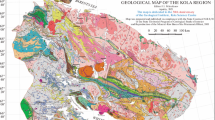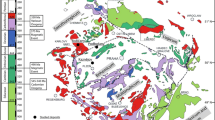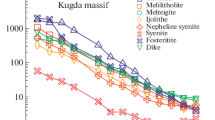Abstract
This work has been carried out to assess the rare-earth potential of the main ore minerals of the Lovozero and Khibiny deposits. The loparite and eudialyte deposits are associated with the giant Lovozero intrusion (Eastern Fennoscandia, Kola Peninsula). There are several deposits of apatite–nepheline ores in the Khibiny complex. All these ores take the leading position in the structure of the raw material base of Russia. The highest contents of the sum of rare earth metals (REMs) are typical of loparite ores (the content of ΣREE in loparites is about 28 wt %), light rare earths sharply dominate over heavy ones (the Ce/Yb ratio is about 78000). The sum of REEs in eudialytes is about 2 wt %. A remarkable feature of eudialyte ores is the high concentration of the heavy REM group (the Ce/Yb ratio is about 14). The apatites of the Khibiny deposits occupy an intermediate position: the Ce/Yb ratio is 680, and the average concentration of the REE sum is 0.9 wt %. The conditions of formation of apatite, loparite, and eudialyte ores are considered.
Similar content being viewed by others
Avoid common mistakes on your manuscript.
In August 2022, the Government of the Russian Federation approved a new list of deficit strategic metals, such as REEs, Nb, Ta, Zr, Hf, U, Th, Sc, and Li. In recent years, special focus has been given to rare earth metals (REMs) because they are key components in many modern technologies, for high-strength magnets, electric vehicle motors, batteries, fluorescent lighting, metallurgy, ceramics, and other industrial sectors.
In Europe, the major research projects EURARE and ASTER for assessing the reserves and quality of rare earth raw materials in Europe have been organized in order to establish the basis for the development of European technologies [1].
Among all types of rocks worldwide, alkaline rocks and carbonatites that control the entire global market of these elements have the highest ore potential for rare earth metals. Russia ranks first in the world in the distribution of alkaline–carbonatite magmatism. This is reflected in the global reserves. In terms of rare earth reserves, Russia ranks second after China. However, Russia lags significantly behind in rare earth processing, accounting for only 2% of global production.
Nearly 90% of all REEs that enter the global market are produced in China (Bayan Obo carbonatite deposit [2]).
The largest deposits of rare lithophile metals are associated with high-temperature magmatic processes. In low-temperature hydrothermal deposits, which are formed due to the mobility and redeposition of rare earth metals, their concentrations can also reach significant levels.
The geodynamic position of REM deposits varies. Most deposits are associated with intracontinental rift zones, for example, the Mesoproterozoic Gardar Province in southwestern Greenland, the world’s largest rare earth metal deposit, is related to Mesoproterozoic carbonatites of China, which formed due to continental rifting. Large occurrences of ultrabasic alkaline–carbonatite rocks and rare earth deposits, for instance, in Eastern Fennoscandia and the Maymecha-Kotui province (Polar Siberia) are also associated with plume magmatism.
The main mineral concentrators of REMs in highly alkaline intrusions are apatite, eudialyte, loparite, steenstrupine, and pyrochlore. A certain portion of rare earth metals is concentrated in REM-bearing minerals such as lovozerite, lamprophyllite, rinkolite, and others.
The main goal of this work is to assess the rare earth potential of the key mineral concentrators in loparite, eudialyte, and apatite deposits of the Lovozero and Khibiny complexes in the Kola Alkaline Province (Table 1). The giant Lovozero intrusion (Eastern Fennoscandia, Kola Peninsula) is associated with large deposits of loparite and eudialyte. The Khibiny complex hosts several large apatite ore deposits. All these deposits have a leading position in the structure of the resource base of Russia and are among the main sources of rare earths, niobium, tantalum, zirconium, hafnium, and potentially radioactive raw materials.
The main research methods for ore minerals throughout the section of the deposits included microprobe analysis (CAMECA-100) and laser ablation inductively coupled plasma mass spectrometry (LA-ICP-MS) (Geological Institute, Russian Academy of Sciences); Smithsonian Institution standards were applied.
The Lovozero layered massif (625 km2) [3] is a pluton formed primarily by three intrusive phases: (1) medium-grained nepheline and noseanic syenites, (2) differentiated complex of urtites, foyaites, and lujavrites, and (3) eudialyte lujavrites. Loparite ores are confined to specific horizons of the Differentiated Complex and are primarily related to urtite layers. The ore horizons enriched in loparite up to several percent are traced to a depth of 870 m (the distance from the lower contact of the Differentiated Complex). In ore horizons, loparite is an early magmatic idiomorphic mineral. Lower in the section, loparite changes its order and forms of crystallization. In the lowest zone (below 870 m from the lower contact), loparite occurs as a late interstitial xenomorphic mineral. The Lovozero alkaline magma becomes saturated with loparite after crystallizing, making up approximately 25% of the magma chamber. The studies also revealed a number of features in the forms of loparite precipitation and composition. Table 1 shows examples of the compositions for idiomorphic and interstitial loparite.
Loparite is the primary REM mineral concentrator in the Lovozero intrusion and contains up to 28 wt %, with light REMs significantly dominating over the heavy ones (Fig. 1). The Ce/Yb ratio is extremely high, reaching 78 000; this is one of the highest ratios among the minerals containing REMs. Stratigraphically upward through the section of the intrusion, loparite becomes depleted in the sum of REM, and the ratio of light REMs to heavy Ce/Yb decreases (Fig. 2). Therefore, loparite, which is the most promising for rare earths, is confined to the lower parts of the Lovozero deposit section. Based on these facts, we have demonstrated [4] that the change in the forms of loparite precipitation (and the time of its crystallization) represents a geochemical criterion of the ore content in alkaline magmas for rare earths, niobium, tantalum, titanium, and potentially uranium and thorium [4].
The eudialyte ore deposit in Lovozero is also among the largest and serves as a source of rare earths, zirconium, hafnium, and niobium. The content of rare earth metals is presented in Table 1. Despite the lower contents of the sum of rare earth elements in eudialyte (~2%, on average) compared to loparite, eudialyte exhibits significantly higher heavy-to-light REM ratios, with a Ce/Yb ratio equal to 14. Thus, eudialyte ore is a unique source of the more valuable heavy rare earth metals.
The detailed petrographic studies of the entire vertical section of the Lovozero deposit revealed a change in the form of eudialyte precipitation. Throughout the depth interval of the Differentiated Complex, eudialyte is crystallized at a late magmatic stage, forming xenomorphic precipitates confined to the interstices of rock-forming minerals [5]. Eudialyte ore bodies are not formed. Upward through the section of phase 3 (at depths of about 400 m from the upper contact), eudialyte becomes an early mineral, forming well-shaped idiomorphic crystals. The forms of eudialyte precipitation do not differ idiomorphically from nepheline, feldspar, amphibole, and aegirine, indicating their simultaneous crystallization during the early magmatic stage. Together with the main rock-forming minerals, eudialyte forms assemblages, and magmatic layering is developed at this stage. Eudialyte ores appear at this stage. Saturation of the initial magma with eudialyte occurs after about 85% of the Lovozero intrusion has been crystallized.
The apatite–nepheline deposits are associated with the Ijolite–urtite intrusion of the Khibiny complex [3].
The use of the geochemical predictive criterion of ore content we developed showed that the apatite-bearing intrusion in Khibiny was saturated with apatite from the beginning of crystallization and contained 2.4 wt % P2O5 [6]. Apatite was crystallized at an early stage along with nepheline. A significant difference in the size of crystals of apatite (0.3 mm) and nepheline (4 mm) led to the separation of these minerals. During active convection, small apatite crystals floated up, forming apatite ore, while the larger nepheline precipitates sank, forming a thick layer of urtite. The average content of the sum of REMs in apatites from four deposits in Khibiny is 0.9 wt %; the Ce/Yb ratio = 680.
An interesting feature of the ore minerals loparite, eudialyte, and apatite is the connection between the distribution pattern of rare earth metals in them and the level at which magma chambers of the Lovozero and Khibiny deposits are filled with sediment (Fig. 2). The concealed layering of ore mineral phases demonstrates the decisive role of crystallization differentiation processes in the genesis of rare metal deposits. For loparites, the value of the combined coefficients of distribution is greater than unity, whereas for apatites and eudialytes, it is less than unity (except for heavy REMs in eudialytes from the Lovozero deposit) (Fig. 2).
A necessary condition for when the rare metal deposits could have formed is the early saturation of the magmatic melt with respect to ore mineral phases. In this case, the convection processes lead to the formation of magmatic layering and ore assemblages.
CONCLUSIONS
The obtained materials have shown that the loparite ores in the Lovozero deposit are highly enriched in rare earths (up to 28 wt %), with the light group significantly dominating over the heavy group (Ce/Yb = 78 000), whereas eudialyte ores (2 wt % content, on average) are significantly enriched in the heavy group of REMs (Ce/Yb = 14). Apatite ores in the Khibiny deposit (0.9 wt % content, on average) are at the intermediate position (Ce/Yb = 680). The ore minerals of the Lovozero and Khibiny deposits, loparite, eudialyte, and apatite, are early magmatic minerals, and the distribution pattern of rare earth metals for them is the result of two factors: the value of the distribution coefficients and the REM content in the initial alkaline magma.
The forms of precipitation and the timing of crystallization of ore minerals (loparite, eudialyte, and apatite) are a predictive criterion of the ore content. A necessary prerequisite for the formation of magmatic rare metal deposits is the early saturation of the magmatic melt with respect to the ore mineral phases.
Change history
25 January 2024
An Erratum to this paper has been published: https://doi.org/10.1134/S1028334X23060028
REFERENCES
K. M. Goodenough, J. Schillingb, E. Jonsson, P. Kalvige, N. Charles, J. Tuduri, E. A. Deady, M. Sadeghi, H. Schiellerup, A. Muller, G. Bertrandf, N. Arvanitidis, D. G. Eliopoulos, R. A. Shawg, K. Thrane, and N. Keulene, Ore Geol. Rev. 72, 838–856 (2016).
J. Wübbeke, Resour. Policy, No. 38, 384–394 (2013).
V. I. Gerasimovskii, V. P. Volkov, L. N. Kogarko, A. I. Polyakov, T. V. Saprykina, and Yu. A. Balashov, Geochemistry of the Lovozero Alkaline Massif (Nauka, Moscow, 1966) [in Russian].
L. N. Kogarko, Dokl. Earth Sci. 505 (2), 524–527 (2022).
L. Kogarko and T. F. D. Nielsen, Minerals, No. 10, 1036 (2020).
L. N. Kogarko, Geol. Ore Deposits 41 (5), 351–367 (1999).
Funding
This study was supported by a State Assignment for Vernadsky Institute of Geochemistry and Analytical Chemistry, Russian Academy of Sciences.
Author information
Authors and Affiliations
Corresponding author
Ethics declarations
The authors of this work declare that they have no conflicts of interest.
Additional information
Translated by L. Mukhortova
Publisher’s Note.
Pleiades Publishing remains neutral with regard to jurisdictional claims in published maps and institutional affiliations.
Rights and permissions
Open Access. This article is licensed under a Creative Commons Attribution 4.0 International License, which permits use, sharing, adaptation, distribution and reproduction in any medium or format, as long as you give appropriate credit to the original author(s) and the source, provide a link to the Creative Commons license, and indicate if changes were made. The images or other third party material in this article are included in the article’s Creative Commons license, unless indicated otherwise in a credit line to the material. If material is not included in the article’s Creative Commons license and your intended use is not permitted by statutory regulation or exceeds the permitted use, you will need to obtain permission directly from the copyright holder. To view a copy of this license, visit http://creativecommons.org/licenses/by/4.0/
About this article
Cite this article
Kogarko, L.N. Rare Earth Element Resource Potential of Super-Large Deposits in Eastern Fennoscandia. Dokl. Earth Sc. 513, 1296–1300 (2023). https://doi.org/10.1134/S1028334X23602067
Received:
Revised:
Accepted:
Published:
Issue Date:
DOI: https://doi.org/10.1134/S1028334X23602067






